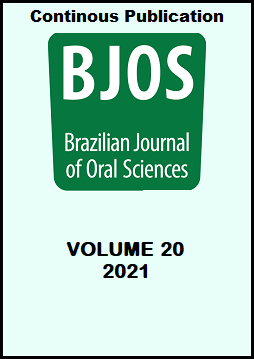Abstract
Sex is one of the first features to be diagnosed in human identification, composing, with age, ancestry and stature, the so called “big four”. Aim: The present study aimed to metrically analyze the sexual dimorphism in skulls of known age and sex from Rio Grande do Sul – Brazil. Methods: This was a crosssectional study of metrical analysis, which used a sample comprised of 209 human skulls (106 male and 103 female) older than 22 years old at the time of death, undamaged and without signs of trauma or abnormalities. The point nasion and the most superior points on the zygomaticotemporal sutures from each side were connected forming a triangle. This area was calculated using Heron’s formula, and the results were submitted for statistical analysis. Results: All measurements showed significant values for sexual dimorphism. Through the area of the triangle, it was possible to determine sex with an accuracy of 83.97% for males and 83.50% for females. Conclusion: This simple method requires only a caliper, and still can be reliable for forensic human identification. It must be diffused and tested on other samples, and can be used as a good and inexpensive tool for experts in day-to-day practice.
References
Krogman W, Iscan MY. The human skeleton in forensic medicine. 2nd ed. Springfield: Charles C Thomas; 1986.
Christensen AM, Passalacqua NV, Bartelink EJ. Sex Estimation. In: Christensen AM, Passalacqua NV, Bartelink EJ. Forensic anthropology: current methods and practice. Cambridge: Academic Press; 2019. p.243-70. doi: 10.1016/B978-0-12-815734-3.00008-7.
Klales AR, editor. Sex estimation of the human skeleton: history, methods, and emerging techniques. Cambridge: Academic Press; 2020.
Walrath DE, Turner P, Bruzek J. Reliability test of the visual assessment of cranial traits for sex determination. Am J Phys Anthropol. 2004;125(2):132-7. doi: 10.1002/ajpa.10373.
İşcan MY. Forensic anthropology of sex and body size. Forensic Sci Int. 2005;147(2-3):107-12. doi.org/10.1016/j.forsciint.2004.09.069
Latham KE, Baterlink EJ, Finnegan M. New perspectives in forensic human skeletal identification. Cambridge: Academic Press; 2017.
Meindl RS, Lovejoy CO, Mensforth RP, Don Carlos L. Accuracy and direction of error in the sexing of the skeleton: implications for paleodemography. Am J Phys Anthropol. 1985;68(1):79-85. doi.org/10.1002/ajpa.1330680108.
Patil KR, Mody RN. Determination of sex by discriminant function analysis and stature by regression analysis: a lateral cephalometric study. Forensic Sci Int. 2005;147(2-3):175-80. doi.org/10.1016/j.forsciint.2004.09.071.
Kranioti EF, Işcan MY, Michalodimitrakis M. Craniometric analysis of the modern Cretan population. Forensic Sci Int. 2008;180(2-3):110.e1-5. doi.org/10.1016/ j.forsciint.2008.06.018.
Steyn M, Işcan MY. Sexual dimorphism in the crania and mandibles of South African whites. Forensic Sci Int. 1998;98(1-2):9-16. doi.org/10.1016/S0379-0738(98)00120-0.
Naikmasur VG, Shrivastava R, Mutalik S. Determination of sex in South Indians and immigrant Tibetans from cephalometric analysis and discriminant functions. Forensic Sci Int. 2010;197(1-3):122.e1-6. doi.org/10.1016/j.forsciint.2009.12.052.
Pappas T. Heron's Theorem. In: Pappas T. The joy of mathematics. San Carlos: Wide World Publishing/Tetra; 1989. p.62.
Rogers TL. Determining the sex of human remains through cranial morphology. J Forensic Sci. 2005;50(3):493-500.
Williams BA, Rogers T. Evaluating the accuracy and precision of cranial morphological traits for sex determination. J Forensic Sci. 2006;51(4):729-35. doi: 10.1111/j.1556-4029.2006.00177.x.
Gill GW. Craniofacial criteria in the skeletal attribution of race. In: Reichs KJ, editor. Forensic osteology: advances in the identification of human remains. 2nd ed. Springfield: Charles C Thomas; 1998. p.293-315.
White TD, Black MT, Folkens PA. Human osteology. San Diego. Academic Press; 2011.
Byers SN. Introduction to forensic anthropology: a textbook. Boston: Allyn and Bacon; 2002.
Stanford C, Allen JS, Antón SC. Biological anthropology: the natural history of humankind. London: Pearson Education; 2016.
Đurić M, Rakočević Z, Đonić D. The reliability of sex determination of skeletons from forensic context in the Balkans. Forensic Sci Int. 2005;147(2-3):159-64. doi: 10.1016/j.forsciint.2004.09.111.
Relethford JH. Race and global patterns of phenotypic variation. Am J Phys Anthropol. 2009;139(1):16-22. doi: 10.1002/ajpa.20900.
Ross AH, Ubelaker DH, Falsetti AB. Craniometric variation in the Americas. Hum Biol. 2002;74(6):807-18. doi: 10.1353/hub.2003.0010.
Urbanová P, Ross AH, Jurda M, Nogueira MI. Testing the reliability of software tools in sex and ancestry estimation in a multi-ancestral Brazilian sample. Leg Med Tokyo. 2014;16(5):264-73. doi: 10.1016/j.legalmed.2014.06.002.
Pena SDJ. [Retrato molecular do Brasil]. Cienc Hoje. 2000;27(159):16-25. Portuguese.
Alves-Silva J, da Silva Santos M, Guimarães PEM, Ferreira AC, Bandelt HJ, Pena SD, et al. The ancestry of brazilian mtDNA lineages. Am J Hum Genet. 2000;67(2):444-61. doi: 10.1086/303004.
Gulhan O, Harrison K, Kiris A. A new computer-tomography-based method of sex estimation: Development of Turkish population-specific standards. Forensic Sci Int. 2015;255:2-8. doi: 10.1016/j.forsciint.2015.07.015.
Mediavilla ER, Pérez BP, González EL, Sánchez JAS, Fernández ED, Sáez AS. Determining sex with the clavicle in a contemporary Spanish reference collection: A study on 3D images. Forensic Sci Int. 2016;261:163.e1-163.e10. doi: 10.1016/j.forsciint.2016.01.029.
Cavaignac E, Savall F, Faruch M, Reina N, Chiron P, Telmon N. Geometric morphometric analysis reveals sexual dimorphism in the distal femur. Forensic Sci Int. 2016;259:246.e1-246.e5. doi: 10.1016/j.forsciint.2015.12.010.

This work is licensed under a Creative Commons Attribution 4.0 International License.
Copyright (c) 2021 Brazilian Journal of Oral Sciences


